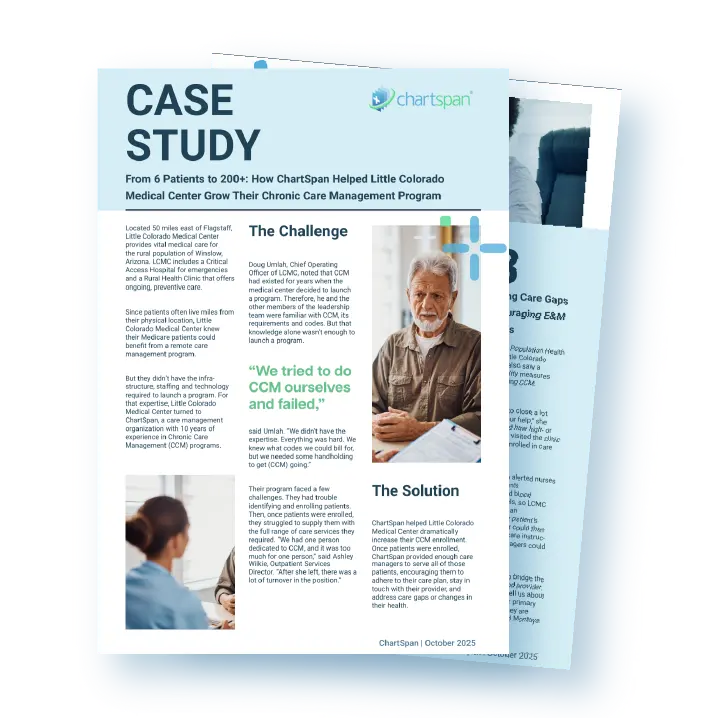
Talk with a ChartSpan Representative Today!
Our team is ready to help you improve patient care and outcomes.
Blog
MIPS 2020 Countdown: 90 Days Until “Show Time”
With about 90 days left in the year that no one expected and few were prepared for, some health care providers may be wondering if the Centers for Medicare and Medicaid Services (CMS) will turn their heads and ignore 2020 MIPS requirements. The truth is, although COVID-19 may have devastated many provider practices across the globe, CMS is not relaxing expectations of the MIPS program for the 2020 performance year. In fact, CMS is legally required to offer the Quality Payment Program (QPP) that rewards value and patient outcomes through Merit-based Incentive Payment System (MIPS) and Advanced Alternative Payment Models (APMs). There is still time left before the MIPS reporting deadline to maximize your impact if you act now.
But you may ask if it is really worth it to participate in MIPS this year? Absolutely, yes. Just because this year was difficult for many, fighting to get over the 45 points is crucial this year as well as for years to come in order to avoid the penalty of a negative MIPS payment adjustment. Imagine what losing up to 9% off the top of your annual Medicare reimbursement means to your practice! In addition to the revenue impact, your publicly available reputation will be on the line now more than ever before.
COVID-19’s Toll on MIPS
Although CMS is not letting practices use the public health crisis as a reason to avoid quality reporting this year, they did make a few accommodations for COVID-19. CMS is incorporating the pandemic into their quality program.
- New Improvement Activity - One of these changes is the addition of Clinical Trial participation as an accepted Improvement Activity. Clinical trials or research development related to COVID-19 will qualify for this activity. This activity holds a high weight towards your 15 required points.
- Telehealth Encounters - Historically, telephone or video appointments did not qualify as a viable encounter to collect quality measures. For 2020, CMS is allowing quality measures to be collected for telehealth visits. This allows virtual care to contribute to your numerator values.
- Complex Patient Care Bonus - CMS is trying to incentivize practices to stay connected with patients who still need an extended level of care, especially during the pandemic. Therefore, CMS increased the complex patient care bonus from 3 to 10 bonus points.
MIPS Hardships and Exemptions
Many practices have experienced a decrease in patient volume during at least some point this year. This has been especially difficult for small practices. There is no doubt that this affects quality reporting. However, this is not a reason for eligible clinicians to claim a hardship. Unfortunately, it will not be approved as an appropriate reason if you do not have a valid reason to claim hardship and it is highly discouraged. Any hardships will need to be proven with significant documentation and can be audited for up to seven years. That said, the types of hardships include:
- The Promoting Interoperability (PI) Hardship exception cannot be related to COVID. An example of a valid PI Hardship is if your Electronic Health Record (EHR) vendor goes out of business (non-COVID related) and you no longer have the needed reporting requirements, or the EHR you use is not a 2015 Certified EHR Technology (CEHRT). This exception will allow the reweighting of one or more of categories based on your answers.
- The Extreme and Uncontrollable Circumstances Hardship allows you to request one or more MIPS performance categories to be reweighted to 0%. Again, a reduction in patient volume will not be approved for a valid excuse.
How to Maximize Your Time Left
With only three months remaining in the year, it’s crunch time for collecting and reporting your quality measures. So how can you get to the best possible place before the end of the reporting year? The Promoting Interoperability and Improvement Activities categories both have a 90-day reporting period, meaning there is still time left in the year to work on these two categories. All other categories, including the cost category and the quality category, are for the full calendar year.
- In the remaining 90-day period, it is best for eligible clinicians to record every patient, every encounter, and every measure that you can. If you haven’t already, include telehealth encounters as well. This will help you maximize capturing data for your Quality category.
- Identify the activities (up to four) that make the most sense for your practice, and how many you need for each. Do these activities and document for the remainder of the year for your Improvement Activities category.
- For the Promoting Interoperability category, focus on the measures that you can do easily. If you have not started your SRA, do so now so that you have ample time to complete it.
Lastly, providers should consider looking for outside consultation if they are struggling with MIPS. Especially during a difficult year like 2020, it’s beneficial to have another set of eyes looking at your data and following-up with you and your team as you work towards a common goal.
Practices who use ChartSpan for their Chronic Care Management (CCM) program are provided with access to a dedicated MIPS specialist at no additional charge. Our MIPS experts analyze our clients’ data through access to reports in their EHRs and conduct monthly consultations to help practices navigate to the best possible final score.
By offering a successful CCM program, ChartSpan’s clients automatically qualify for the full Improvement Activities category weight. Our CCM team works to continuously identify and close gaps in care so that providers don’t have to do the heavy lifting. We create a focus on disease management opportunities and drive patients back into your office, where you can address quality measures. Our team performs so well that in 2019, 83% of ChartSpan customers earned additional bonus points on top of their positive payment adjustment and averaged a median score of 93%.
For more information on how you can receive MIPS guidance with ChartSpan, please visit https://www.chartspan.com/solution/mips/.
Subscribe for More Insights
Get valuable resources delivered straight to your inbox.
"*" indicates required fields





